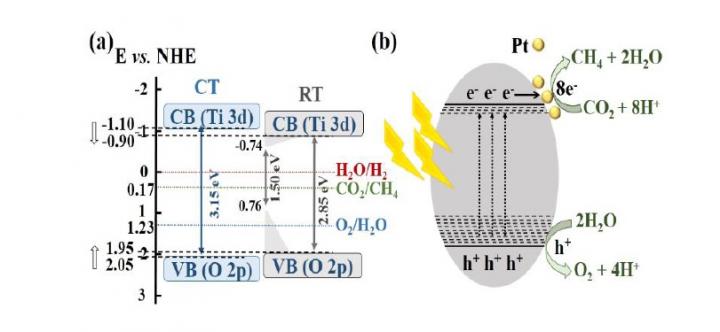New photocatalyst speeds up the conversion of carbon dioxide into chemical resources

A schematic diagram showing the mechanism of the conversion of carbon dioxide into methane using the reduced titanium dioxide developed by the team. Credit: DGIST
Carbon dioxide is a major cause of global warming. Therefore, in order to control atmostpheric carbon dioxide concentration, many countries are actively working on numerous studies to investigate effective ways to transform carbon dioxide into chemical fuels such as methane, ethane and methanol.
In particular, a high-efficiency photocatalyst is essential to help prevent the generation of secondary harmful substances when converting carbon dioxide into chemical fuels.
The research team has applied a simple magnesiothermic reduction method to synthesize oxygen-deficient titanium dioxide by removing oxygen atoms on the surface of titanium dioxide, which turns out to be a high-efficient photocatalyst that can effectively convert carbon dioxide into methane.
The research team mentions that the newly developed photocatalyst illustrates controlled band gap by removing oxygen atoms on the surface of titanium dioxide through strong reduction of magnesium and hydrogen. This band gap control improves the light absorption and optimizes the efficient charge separation.
As a result, the photocatalyst is found to increase conversion rate of carbon dioxide into methane up to threefold compared to the existing photocatalyst.
In addition, the study demonstrates that reduced titanium dioxide photocatalyst developed by DGIST team is superior to that of the existing titanium dioxide in terms of the conversion efficiency of carbon dioxide into methane.
It also highlights the excellence of the current magnesiothermic reduction method which was applied for the preparation of reduced titanium dioxide photocatalyst through a relatively simple thermoreduction method with Mg metal and hydrogen gas.
Professor Su-Il In stated “The key of this study is that we have improved the efficiency of the existing titanium dioxide photocatalyst by using a relatively simple magnesiothermic reduction method.”
He added “By understanding the conversion mechanism of carbon dioxide into hydrocarbon, we expect to apply it to use carbon dioxide as resource in abatement technologies.”
Media Contact
All latest news from the category: Life Sciences and Chemistry
Articles and reports from the Life Sciences and chemistry area deal with applied and basic research into modern biology, chemistry and human medicine.
Valuable information can be found on a range of life sciences fields including bacteriology, biochemistry, bionics, bioinformatics, biophysics, biotechnology, genetics, geobotany, human biology, marine biology, microbiology, molecular biology, cellular biology, zoology, bioinorganic chemistry, microchemistry and environmental chemistry.
Newest articles

NASA: Mystery of life’s handedness deepens
The mystery of why life uses molecules with specific orientations has deepened with a NASA-funded discovery that RNA — a key molecule thought to have potentially held the instructions for…

What are the effects of historic lithium mining on water quality?
Study reveals low levels of common contaminants but high levels of other elements in waters associated with an abandoned lithium mine. Lithium ore and mining waste from a historic lithium…

Quantum-inspired design boosts efficiency of heat-to-electricity conversion
Rice engineers take unconventional route to improving thermophotovoltaic systems. Researchers at Rice University have found a new way to improve a key element of thermophotovoltaic (TPV) systems, which convert heat…



